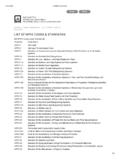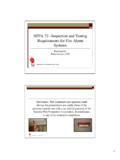Transcription of NFPA 72-2010 Changes - ETNEWS.ORG
1 nfpa 72- 2010 National Fire Alarm and Signaling Code Copyright 2010 Michael B. Baker, SET Page 1 What follows are the Changes that I found, as compared to the 2007 edition. KEY: Strikethrough text = deleted text Underlined text = new text Chapter 1 Administration Chapter 2 Referenced Publications Chapter 3 Definitions Chapter 4 Reserved Chapter 5 Reserved Chapter 6 Reserved Chapter 7 Reserved Chapter 8 Reserved Chapter 9 Reserved Chapter 10 Fundamentals Chapter 11 Reserved Chapter 12 Circuits and Pathways Chapter 13 Reserved Chapter 14 Inspection, Testing, and Maintenance Chapter 15 Reserved Chapter 16 Reserved Chapter 17 Initiating Devices Chapter 18 Notification Appliances Chapter 19 Reserved Chapter 20 Reserved Chapter 21 Emergency Control Functions and Interfaces Chapter 22 Reserved Chapter 23 Protected Premises Fire Alarm Systems Chapter 24 Emergency Communications Systems (ECS)
2 Chapter 25 Reserved Chapter 26 Supervising Station Alarm Systems Chapter 27 Public Emergency Alarm Reporting Systems Chapter 28 Reserved Chapter 29 Single- and Multiple-Station Alarms and Household Fire Alarm Systems nfpa 72- 2010 National Fire Alarm and Signaling Code Copyright 2010 Michael B. Baker, SET Page 2 Annex A Explanatory Material Annex B Engineering Guide for Automatic Fire Detector Spacing Annex C System Performance and Design Guide Annex D Speech Intelligibility Annex E NEMA SB 30, Fire Service Annunciator and Interface Annex F Sample Ordinance Adopting nfpa 72 Annex G Wiring Diagrams and Guide for Testing Fire Alarm Circuits Annex H Informational References Annex I Cross-Reference Table Index nfpa 72- 2010 National Fire Alarm and Signaling Code Copyright 2010 Michael B. Baker, SET Page 3 Chapter 1 Administration nfpa 72 covers the application, installation, location, performance, inspection, testing, and maintenance of fire alarm systems, supervising station alarm systems, public emergency alarm reporting systems, fire warning equipment and emergency warning equipment communications systems (ECS), and their components.
3 The purpose of this Code is to define the means of signal initiation, transmission, notification, and annunciation; the levels of performance; and the reliability of the various types of fire alarm systems, supervising station alarm systems, public emergency alarm reporting systems, fire warning equipment, emergency communications systems, and their components. * This Code shall not be interpreted to require a level of fire protection that is greater than that which would otherwise be required by the applicable building or fire code. Alarm systems shall be classified as follows: (1) Fire alarm systems (a) Household fire alarm systems (b) Protected premises (local) fire alarm systems (2) Supervising station alarm systems (a) Central station (service) fire alarm systems (b) Remote supervising station fire alarm systems (c) Proprietary supervising station fire alarm systems (3) Public fire emergency alarm reporting systems (a) Auxiliary fire alarm systems local energy type (b) Auxiliary fire alarm systems shunt type Emergency communications systems shall be classified as follows.
4 (1) One-way emergency communications systems (a) Distributed recipient mass notification systems (b) In-building fire emergency voice/alarm communications systems (c) In-building mass notification systems (d) Wide area mass notification systems (2) Two-way emergency communications systems (a) In-building emergency communications systems The units of measure in this Code are presented in the International System (SI) of units. Where presented, customary units (inch-pound units) follow the SI units in parentheses. Where both systems of units are presented, either system shall be acceptable for satisfying the requirements in this Code the International System (SI) of units follow the inch-pound units in parentheses. Where extracted text contains values dimensions are expressed in only one system of units inches, the values in the extracted text have been retained without conversion to preserve the values established by the responsible technical committee in the source document it is intended that the precision of the measurement be 1 in.
5 , thus nfpa 72- 2010 National Fire Alarm and Signaling Code Copyright 2010 Michael B. Baker, SET Page 4 plus or minus in. The conversion and presentation of dimensions in millimeters would then have a precision of 25 mm, thus plus or minus 13 mm. nfpa 72- 2010 National Fire Alarm and Signaling Code Copyright 2010 Michael B. Baker, SET Page 5 Chapter 2 Referenced Publications ANSI/UL 864, Standard for Control Units and Accessories for Fire Alarm Systems, 2003, revised 2006. ISO 7240-19, Fire Detection and Alarm Systems Part 19: Design, Installation, Commissioning and Service of Sound Systems for Emergency Purposes, 8/15/07. ISO 7731, Danger signals for work places Auditory danger signals. Telcordia Publications. One Telcordia Drive, Piscataway, NJ 08854. GR-506-CORE, LATA Switching Systems Generic Requirements: Signaling for Analog Interface, 2006.
6 GR-909-CORE, Fiber in the Loop Systems Generic Requirements, 2004. nfpa 72- 2010 National Fire Alarm and Signaling Code Copyright 2010 Michael B. Baker, SET Page 6 Chapter 3 Definitions * Acoustically Distinguishable Space (ADS). An emergency communications system notification zone, or subdivision thereof, that might be an enclosed or otherwise physically defined space, or that might be distinguished from other spaces because of different acoustical, environmental, or use characteristics, such as reverberation time and ambient sound pressure level. (SIG-NAS) Acoustically Distinguishable Space (ADS). All parts of a building or area intended to have occupant notification are subdivided into ADSs as defined. Some ADSs might be designated to have voice communication capability and require that those communications be intelligible.
7 Other spaces might not require voice intelligibility or might not be capable of reliable voice intelligibility. An ADS might have acoustical design features that are conducive for voice intelligibility, or it might be a space where voice intelligibility could be difficult or impossible to achieve. Each is still referred to as an ADS. In smaller areas, such as those under 400 ft2 (40 m2), walls alone will define the ADS. In larger areas, other factors might have to be considered. In spaces that might be subdivided by temporary or movable partitions, such as ballrooms and meeting rooms, each individual configuration should be considered a separate ADS. Physical characteristics, such as a change in ceiling height of more than 20 percent, or a change in acoustical finish, such as carpet in one area and tile in another, would require those areas to be treated as separate ADSs.
8 In larger areas, there might be noise sources that require a section to be treated as a separate ADS. Any significant change in ambient noise level or frequency might necessitate an area be considered a separate ADS. In areas of 85 dBA or greater ambient sound pressure level, meeting the pass/fail criteria for intelligibility might not be possible, and other means of communication might be necessary. So, for example, the space immediately surrounding a printing press or other high-noise machine might be designated as a separate ADS, and the design might call for some form of effective notification but not necessarily require the ability to have intelligible voice communication. The aisles or operator s control stations might be separate ADSs where intelligible voice communication might be desired. Significant differences in furnishings, for example, an area with tables, desks, or low dividers, adjacent to an area with high shelving, would require separate consideration.
9 The entire desk area could be a single acoustic zone, whereas each area between shelving could be a unique zone. Essentially, any noteworthy change in the acoustical environment within an area will mandate consideration of that portion of the area to be treated as an acoustic zone. Hallways and stairwells will typically be considered as individual acoustic zones. Spaces confined by walls with carpeting and acoustical ceilings can be deemed to be one ADS. An ADS should be an area of consistent size and material. A change of materials from carpet to hard tile, the existence of sound sources, such as decorative waterfalls, large expanses of glass, and Changes in ceiling height, are all factors that might separate one ADS from another. Each ADS might require different components and design features to achieve intelligible voice communication.
10 For example, two ADSs with similar acoustical treatments and noise levels might have different ceiling heights. The ADS with the lower ceiling height nfpa 72- 2010 National Fire Alarm and Signaling Code Copyright 2010 Michael B. Baker, SET Page 7 might require more ceiling-mounted speakers to ensure that all listeners are in a direct sound field (see Figure ). Other ADSs might benefit from the use of alternate speaker technologies, such as line arrays, to achieve intelligibility. An ADS that differs from another because of the frequency and level of ambient noise might require the use of speakers and system components that have a wider frequency bandwidth than conventional emergency communications equipment. However, designers should not use higher bandwidth speakers in all locations, unless needed to overcome certain acoustic and ambient conditions.





